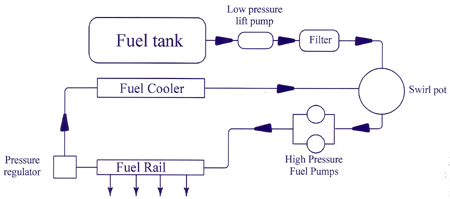Fuel delivery
As a development engineer for more than 30 years, and an enthusiast for a lot longer, I have seen many fuel systems installed in race and rally cars across the land. Some of them are very good, some not so. Most will obviously work sufficiently well 95% or even 99% of the time or else the owners would presumably modify them to suit, but there may be times when ambient temperatures are high or fuel levels very low when they can be caught out. The enemy of any fuel system for the spark-ignition engine is heat.
Gasoline, whether it is used for the road or track, consists of a range of different volatile hydrocarbons, each with its own boiling point, beginning at around 25-35 C (initial boiling point, or IBP) and finishing in the region of 180-215 C (the FBP, or final boiling point). The 'lighter' or low-boiling-point constituents of the fuel enable starting from cold and help initiating of the flame front, while as we move to the 'heavier' or higher boiling point ends, these tend to be more dense and deliver the power.
A fuel may therefore be blended to deliver more power, but without any additional conditioning equipment such as fuel heaters, ambient conditions of temperature (and pressure in some cases) have to be taken into account. However, few of us have the luxury of being able to design our own fuel, so what we tend to use is a compromise to give us the ability to start our engines and run them to deliver best performance at acceptable usage levels. It is nevertheless the problem of starting the engine that produces many of the issues we see when ambient conditions move to the extremes or when the fuel 'delivery' system is not up to the task. It is under these conditions that the phenomenon of vapour lock or boiling of these 'lighter' ends occurs.
A good fuel system, whether it is for indirect, port injection or direct injection into the cylinder, will at first scavenge the fuel out of the tank (or tanks), filter it and then present it to the high-pressure pumps, which will pump it towards the fuel injectors. As we pump it through the system, the pressure in the line obviously increases, but so invariably does the temperature. In addition, the heat generated in the injectors - (electric current)2 x its resistance, remember? - is considerable and needs the fuel to cool them and take it away out of harm's way.
So, while only part of the fuel is consumed through the engine, most of what is pumped needs to be directed elsewhere. For this the fuel will pass through the pressure regulator, which is designed to maintain pressure to the injectors, then drop it to a lower pressure, at which time these lighter ends may boil and create fuel vapour in the return line. It is in this return line that the best designs will fit a fuel cooler and have the fuel returned to some kind of collector or swirl pot to eliminate any air or vapour before being fed back into the high-pressure pumps.
Clearly, to avoid this phenomenon of vapour lock, many other precautions to eliminate heat into the fuel lines may have to be taken, but the best one in my opinion is to fit a fuel cooler.

Fig. 1 - A good fuel system
Written by John Coxon